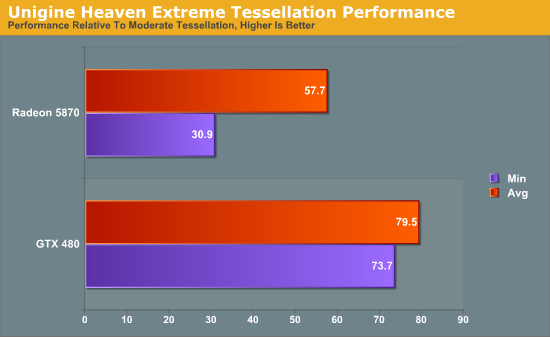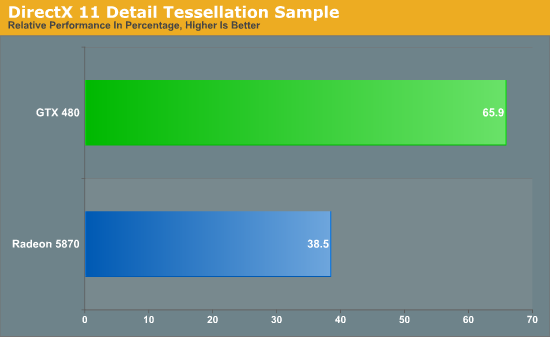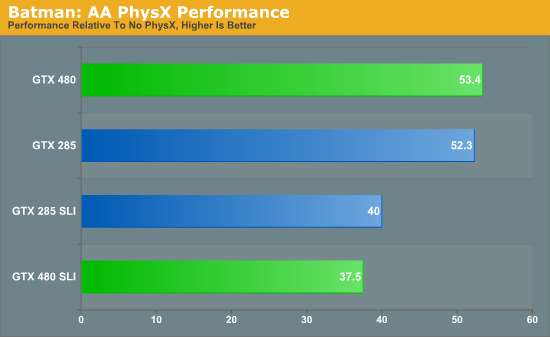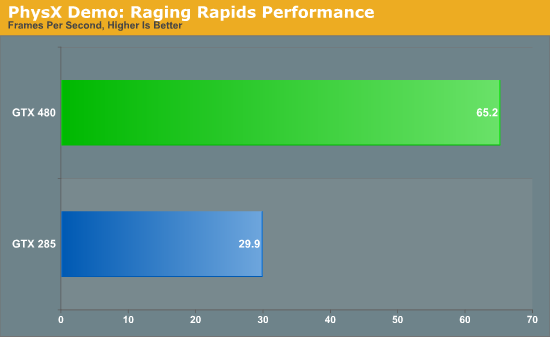NVIDIA’s GeForce GTX 480 and GTX 470: 6 Months Late, Was It Worth the Wait?
by Ryan Smith on March 26, 2010 7:00 PM EST- Posted in
- GPUs
Tessellation & PhysX
We’ll kick off our in-depth look at the performance of the GTX400 series with Tessellation and PhysX. These are two of the biggest features that NVIDIA is pushing with the GTX400 series, with tessellation in particular being the major beneficiary of NVIDIA’s PolyMorph Engine strategy.

As we covered in our GF100 Recap, NVIDIA seeks to separate themselves from AMD in spite of the rigid feature set imposed by DirectX 11. Tessellation is one of the ways they intend to do that, as the DirectX 11 standard leaves them plenty of freedom with respect to tessellation performance. To accomplish this goal, NVIDIA needs significantly better tessellation performance, which has lead to them having 14/15/16 tesselators through having that many PolyMorph Engines. With enough tessellation performance NVIDIA can create an obvious image quality improvement compared to AMD, all the while requiring very little on the part of developers to take advantage of this.
All things considered, NVIDIA’s claim of having superior tessellation performance is one of the easiest claims to buy, but all the same we’ve gone ahead and attempted to confirm it.
Our first tessellation test is the newly released Unigine Heaven 2.0 benchmark, which was released a few days ago. 2.0 added support for multiple levels of tessellation (with 1.0 having earned a reputation of using extreme levels of tessellation), which allows us to look at tessellation performance by varying tessellation levels. If the GTX 480’s tessellation capabilities are several times faster than the Radeon 5870’s as NVIDIA claims, then it should better handle the increased tessellation levels.
Since Heaven is a largely a synthetic benchmark at the moment (the DX11 engine isn’t currently used in any games) we’ll be focusing on the relative performance of cards to themselves in keeping with our editorial policy of avoiding synthetic GPU tests when possible.

Heaven: Moderate & Extreme Tessellation
Heaven has 4 tessellation levels: off, moderate, normal, extreme. For our test we’re using the moderate and extreme modes, comparing the performance of extreme as a percentage of moderate performance.

Starting with averages, the GTX 480 keeps 79% of its performance moving from moderate to extreme. On the Radeon 5870 however, the performance drop-off is much more severe, losing 42% of its performance to bring it down to 58%.
The minimum framerates are even more telling. The GTX 480 minimum framerates drop by 26% when switching to extreme tessellation. The Radeon 5870 is much worse off here, bringing in minimum framerates 69% lower when using extreme tessellation. From these numbers it’s readily apparent that the GTX 480 is much more capable of dealing with very high tessellation levels than the Radeon 5870 is.
Our second tessellation test is similar in nature, this time taken from one of Microsoft’s DX11 sample programs: Detail Tessellation. Detail Tessellation is a simple scene where tessellation plus displacement mapping is used to turn a flat rock texture in to a simulated field of rocks by using tessellation to create the geometry. Here we measure the average framerate at different tessellation factors (7 and 11) and compare the framerate at the higher tessellation factor to the lower tessellation factor.


Looking at just the averages (the framerate is rather solid) we see that the GTX 480 retains 65% of its performance moving from factor 7 to factor 11. The Radeon 5870 on the other hand only retains 38% of its performance. Just as what we saw in Unigine, the GTX 480 takes a much lighter performance hit from higher tessellation factors than the Radeon 5870 does, driving home the point that the GTX 480 has a much more powerful tessellator.
With the results of these tests, there’s no reason to doubt NVIDIA’s claims about GF100’s tessellation abilities. All the data we have points GF100/GTX 480 being much more powerful than the Radeon 5000 series when it comes to tessellation.
But with that said, NVIDIA having a more powerful tessellator doesn’t mean much on its own. Tessellation is wholly dependent on game developers to make use of it and to empower users to adjust the tessellation levels. Currently every DX11 game using tessellation uses a fixed amount of it, so NVIDIA’s extra tessellation abilities are going unused. This doesn’t mean that tessellation will always be used like this, but it means things have to change, and counting on change is a risky thing.
NVIDIA’s superior tessellation abilities will require that developers offer a variable degree of tessellation in order to fully utilize their tessellation hardware, and that means NVIDIA needs to convince developers to do the extra work to implement this. At this point there’s no way for us to tell how things will go: NVIDIA’s superior tessellation abilities could be the next big thing that seperates them from AMD like they’re shooting for, or it could be the next DirectX 10.1 by being held back by weaker hardware. Without some better sense of direction on the future use of tessellation, we can’t make any recommendations based on NVIDIA’s greater tessellation performance.
Moving on we have PhysX, NVIDIA’s in-house physics simulation middleware. After picking up PhysX and its developer AGEIA in 2008, NVIDIA re-implemented PhysX hardware acceleration as a CUDA application, allowing their GPUs to physics simulations in hardware. NVIDIA has been pushing it on developers and consumers alike with limited success, and PhysX only finally had a breakthrough title last year with the critically acclaimed Batman: Arkham Asylum.
With Fermi’s greatly enhanced compute abilities, NVIDIA is now pushing the idea that PhysX performance will be much better on Fermi cards, allowing developers to use additional and more complex physics actions than ever before. In particular, with the ability to use concurrent kernels and the ability to do fast context switching, PhysX should have a reduced degree of overhead on Fermi hardware than it did on GT200/G80 hardware.
To put this idea to the test, we will be using the Batman: Arkham Asylum benchmark to measure PhysX performance. If PhysX has less overhead on Fermi hardware then the framerate hit on the GTX 480 from enabling PhysX effects should be lower than the framerate hit on the GTX 285. For this test we are running at 2560x1600, comparing performance between PhysX being disabled and when it’s set on High.

If PhysX has less overhead on Fermi hardware, Batman is not the game to show it. On both the GTX 480 and the GTX 285, the performance hit on a percentage basis for enabling PhysX is roughly 47%. The GTX 480 may be faster overall, but it takes the same heavy performance hit for enabling PhysX. The SLI cards fare even worse here: the performance hit for enabling PhysX is 60% on both the GTX 480 SLI and the GTX 285 SLI.
PhysX unquestionably has the same amount of overhead on the GTX 480 as it does the GTX 285. If PhysX is going to take up less overhead, then from what we can gather it either will be a benefit limited to PhysX 3, or will require future PhysX 2.x updates that have yet to be delivered.
Or second PhysX test is a more generalized look at PhysX performance. Here we’re using NVIDIA’s Raging Rapids tech demo to measure PhysX performance. Raging Rapids is a water simulation demonstration that uses PhysX to simulate waves, waterfalls, and more. Here we are measuring the framerate in the demo’s benchmark mode.


Overall the Raging Rapids benchmark gives us mixed results. Out of all of the benchmarks we have run on the GTX 480, this is one of the larger performance jumps over the GTX 285. On the other hand, once we compensate for the GTX 480’s additional shaders, we end up with a result only around 10% faster than a strict doubling in performance. This is a sign of good scaling, but it isn’t a sign that the GTX 480 is significantly faster than the GTX 285 due to more efficient use of compute resources. Just having all of this extra compute power is certainly going to make a difference overall, but on an architectural level the GTX 480 doesn’t look to be significantly faster at PhysX than the GTX 285 on a per-clock/per-shader basis.











196 Comments
View All Comments
Headfoot - Monday, March 29, 2010 - link
Unless you are an insider all of this "profitability" speculuation is just that, useless speculation.The reason they make both companies chips is more likely due to diversification, if one company does poorly one round then they are not going to go down with them. I'd hate to make ATI chips during the 2900XT era and i'd hate to make nVidia chips during the 5800 FX era
blindbox - Saturday, March 27, 2010 - link
I know this is going to take quite a bit of work, but can't you colour up the main cards and its competition in this review? By main cards, I mean GTX 470, 480 and 5850 and 5870. It's giving me a hard time to make comparison. I'm sure you guys did this before.. I think.It's funny how you guys only coloured the 480.
blindbox - Saturday, March 27, 2010 - link
I know this is going to take quite a bit of work, but can't you colour up the main cards and its competition in this review? By main cards, I mean GTX 470, 480 and 5850 and 5870. It's giving me a hard time to make comparison. I'm sure you guys did this before.. I think.It's funny how you guys only coloured the 480.
iwodo - Saturday, March 27, 2010 - link
If i remember correctly Nvidia makes nearly 30- 40% of their Profits from Telsa and Quadro. However Telsa and Quadro only occupies 10% of their Total GPU volume shipment. Or 20% if we only count desktop GPU.Which means Nvidia is selling those Perfect grade Fermi 512 Shader to the most profitable market. And they are just binning these chips to lower grade GTX 480 and GTX 470. While Fermi did not provide the explosion of HPC sales as we initially expected due to heat and power issues, but judging by pre-order numbers Nvidia still has quite a lot of orders to fulfill.
The Best thing is we get another Die Shrink in late 2010 / early 2011 to 28nm. ( It is actually ready for volume production in 3Q 2010 ). This should bring Lower Power and Heat. Hopefully the next update will get us a much better Memory Controller, with 256Bit controller and may be 6Ghz+ GDDR5 should offer enough bandwidth while getting better yield then 384Bit Controller.
Fermi may not be exciting now, but it will be in the future.
swing848 - Saturday, March 27, 2010 - link
We are not living in the future yet.When the future does arrive I expect there will also be newer, better hardware.
Sunburn74 - Saturday, March 27, 2010 - link
So how do you guys test temps? It's not specifically stated. Are you using a case? An open bench? Using readings from a temp meter? Or system readings from catalyst or nvidia control panel? Please enlighten. It's important because people will eventually have to extrapolate your results to their personal scenarios which involve cases of various designs. 94 degrees measured inside a case is completely different from 94 degrees measured on an open bench.Also, why are people saying all this stuff about switching sides and families? Just buy the best card available in your opinion. I mean it's not like ATI and Nvidia are feeding you guys and clothing your kids and paying your bills. They make gpus, something you plug into a case and forget about if it's working properly. I just don't get it :(
Ryan Smith - Saturday, March 27, 2010 - link
We're using a fully assembled and closed Thermaltake Spedo with a 120mm fan directing behind the video cards feeding them air. Temperatures are usually measured with GPU-Z unless for some reason it can't grab the temps from the driver.hybrid2d4x4 - Saturday, March 27, 2010 - link
Thanks for elaborating on the temps as I was wondering about that myself. One other thing I'd like to know is how the VRM and RAM temps are on these cards. I'm assuming that the reported values are for just the core.The reason I ask is that on my 4870 with aftermarket cooling and the fan set pretty low, my core always stayed well below 65, while the RAM went all the way up to 115 and VRMs up to ~100 (I have obviously increased fan speeds as the RAM temps were way too hot for my liking- they now peak at ~90)
Ryan Smith - Saturday, March 27, 2010 - link
Correct, it's just the core. We don't have VRM temp data for Fermi. I would have to see if the Everest guys know how to read it, once they add support.shiggz - Friday, March 26, 2010 - link
I just am not interested in a card with a TDP over 175W. When I upgraded from 8800gt to GTX 260 It was big jump in heat and noise and definitely at my tolerance limit during the summer months. I found myself under-clocking a card I had just bought.175W max though a 150W is preferred @ 250$ and I am ready to buy if NVIDIA wont make it then I will switch back to ATI.